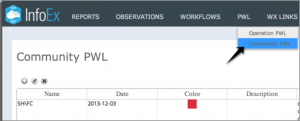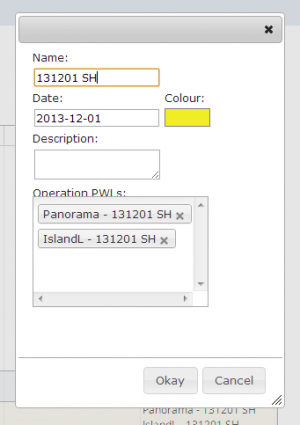Difference between revisions of "Modifying the information for an existing community PWL"
(→Step-by-step description) |
(→Step-by-step description) |
||
| Line 19: | Line 19: | ||
|- | |- | ||
|class="StepNum" | 3. | |class="StepNum" | 3. | ||
| − | |[[File: | + | |[[File:CommunityPWLEdit.png|300px|thumb|right|Fig. 2: Editing the information for a Community PWL]]Click on the [[file:ButtonEdit.png]] button beneath the 'Community PWL' title to open a pop-up window where you can modify the information for Community PWL (Fig. 2). |
Provide the following baseline information for your new Community PWL: | Provide the following baseline information for your new Community PWL: | ||
Revision as of 07:40, 3 January 2014
| REQUIREMENTS | |
| Permission | Operation administrator and higher |
| Connectivity | Online |
This document describes how to modify the information of a community PWL in the InfoEx system.
Background
Community persistent weak layers (Community PWLs) is a new concept in the InfoEx system. Since PWLs often exhibit significant spatial variability and might be buried on a range of days, individual operations might create their Operation PWLs differently. Community PWLs provide a mechanism for linking operation controlled Operation PWLs that relate to the same PWL in nature. This grouping of Operation PWLs allows for more meaningful queries in the InfoEx. For example, the community PWL functionality will allow users to more efficiently get a comprehensive picture on the assessments of a PWL that covers a large area and effectively visualize the associated observed avalanche activity.
| NOTE | Please note that the avalanche problem/PWL filtering functionality for taking taking full advantage of PWL information the InfoEx report has not been implemented yet! |
Step-by-step description
| NOTE | At this point any user with Submission Moderator permissions can create Community PWLs. However, once the necessary filtering functionality, the idea is that the CAC would be taking the lead in managing the Community PWLs that they are in the best position to assess large scale patterns. However, operators always has the ability to unlink their Operation PWLs from a specific Community PWLs if they disagree with the grouping. |
Related documents
Operation PWLs
- Creating a new operation PWL
- Modifying the baseline information of an existing operation PWL
- Deleting an existing operation PWL
Community PWLs
- Creating a new community PWL
- Modifying the information for an existing community PWL
- Deleting an existing community PWL
Assessing PWLs
Functionality tested by
- Jan. 2, 2014: Pascal Haegeli

